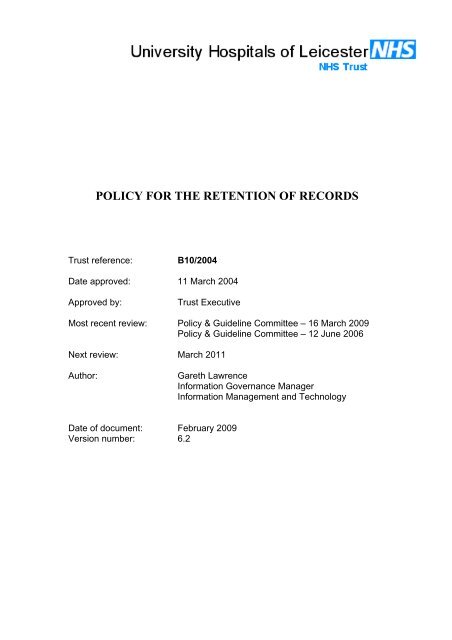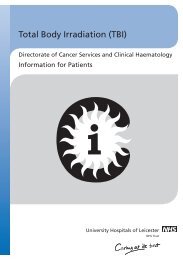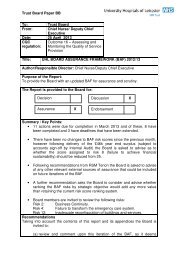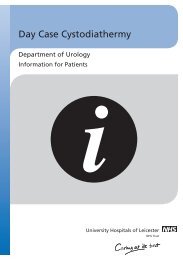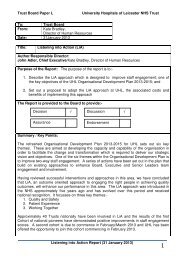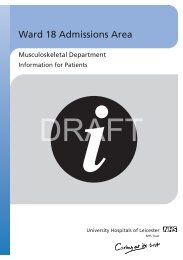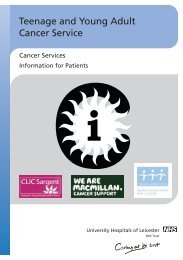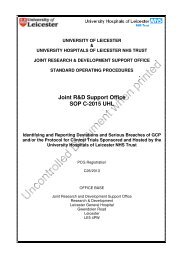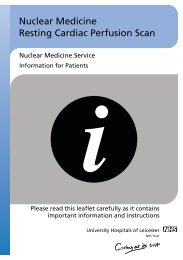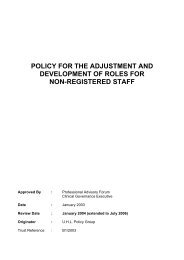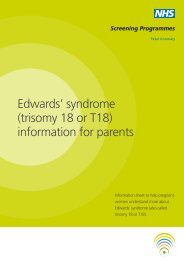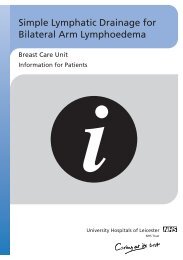Retention of Records Policy - Library
Retention of Records Policy - Library
Retention of Records Policy - Library
Create successful ePaper yourself
Turn your PDF publications into a flip-book with our unique Google optimized e-Paper software.
POLICY FOR THE RETENTION OF RECORDSTrust reference: B10/2004Date approved: 11 March 2004Approved by:Trust ExecutiveMost recent review: <strong>Policy</strong> & Guideline Committee – 16 March 2009<strong>Policy</strong> & Guideline Committee – 12 June 2006Next review: March 2011Author:Gareth LawrenceInformation Governance ManagerInformation Management and TechnologyDate <strong>of</strong> document: February 2009Version number: 6.2
Contents1. Introduction ..................................................................................................32. Scope...........................................................................................................43. Responsibilities ............................................................................................44. Local retention periods.................................................................................45. Information disposal.....................................................................................56. Further References ......................................................................................57. Contacts.......................................................................................................58. <strong>Retention</strong> Schedules....................................................................................58.1. Health <strong>Records</strong>......................................................................................78.2. Administrative – Corporate and Organisation......................................348.3. Estates and Engineering .....................................................................428.4 Financial...............................................................................................458.5 IM&T.....................................................................................................538.6. Other ...................................................................................................538.7. Personnel/HR ......................................................................................548.8 Purchasing and Supplies......................................................................56Change ControlContact the Information Governance Manager for any changes to thisdocument.Version Date Author Change6 6/06 GL This document was first released in March 2004 based onHSC1999/053 – For the RecordThis version is a significant upgrade based on the NHS Code <strong>of</strong><strong>Records</strong> Management Practice. The document will be updated asnew local or national retention periods are defined.6.1 7/08 GL Add declarations <strong>of</strong> interest in the admin records section.Clarify family planning recordsInclude operating theatre lists.Include cardiac arrest trolley daily checksInclude verbal complaintsInclude reference to breast screening guidanceSickness absence forms – HR records minorNot agreed by the P&GC.6.2 2/09 GL Updated in line with the NHS reissuing the NHS Code <strong>of</strong> Practice,8/1/2009
1. IntroductionThis <strong>Policy</strong> is one <strong>of</strong> a suite <strong>of</strong> policies and procedures relating to themanagement <strong>of</strong> information.This retention schedule details the Minimum <strong>Retention</strong> Period for each type<strong>of</strong> health record. <strong>Records</strong> (whatever the media) may be retained for longer thanthe minimum period. However, records should not ordinarily be retained formore than 30 years. Where a period longer than 30 years is required (eg to bepreserved for historical purposes), or for pre 1948 records, contact theInformation Governance Manager who will discuss transfer <strong>of</strong> the information tothe local <strong>Records</strong> Office.The following types <strong>of</strong> record are covered in this retention schedule (regardless<strong>of</strong> the media on which they are held, including paper, electronic, images andsound, and including all records <strong>of</strong> NHS patients treated on behalf <strong>of</strong> the NHSin the private healthcare sector):• patient health records (electronic or paper based, and concerning allspecialities);• staff records;• corporate and administrative records;• records <strong>of</strong> private patients seen on NHS premises;• Accident & Emergency, birth and all other related registers;.Page 3 <strong>of</strong> 57
• theatre, minor operations and other related registers;• X-ray and imaging reports, output and images;• photographs, slides and other images;• micr<strong>of</strong>orm (ie micr<strong>of</strong>iche/micr<strong>of</strong>ilm);• audio and video tapes, cassettes, CD-ROMs, etc;• e- mails 1 ;• computerised records; and• scanned documents.2. ScopeThis policy is applicable to all Trust employees and any organisation undercontract to the Trust.3. Responsibilities<strong>Records</strong> <strong>of</strong> the NHS and its predecessor bodies are subject to the Public<strong>Records</strong> Act 1958, which imposes a statutory duty <strong>of</strong> care directly upon allindividuals who have direct responsibility for any such records.Trust employees and partner organisations are reminded that recordscontaining personal information are subject to the Data Protection Act 1998.Information containing persona; or sensitive data should be disposed <strong>of</strong>confidentially.4. Local retention periodsWhen information does not fall under the listed schedules, local retentionperiods should be determined. The following issues should be considered:• how <strong>of</strong>ten is the information used;• are retention periods for similar information in existence;1 This emphasis that an e-mail can contains information (eg patient care details) which shouldbe retained. Arrangements should be made for that information to be accessed during thatretention period (eg copied into an electronic system or printed and stored in the patientrecord). This does not conflict with the general advice to manage personal mailboxes..Page 4 <strong>of</strong> 57
• what are the consequences <strong>of</strong> that information not being available, forexample, to answer complaints or queries. Remember that the NHS is notrequired to keep information just in case;• who in the directorate/Trust will need to agree the decision.When a local decision on retention has been made, contact the InformationGovernance Manager to have the details recorded in this policy.5. Information disposalBefore destroying records please refer to the Information Disposal Guideline(B34/2005). This document advises on the considerations required to destroyphysical and electronic information such as selecting information fordestruction, validating the selection and record keeping (<strong>of</strong> the recordsdestroyed).6. Further ReferencesThe NHS Code <strong>of</strong> Record Management Practicehttp://www.dh.gov.uk/PublicationsAndStatistics/Publications/Publications<strong>Policy</strong>AndGuidance/Publications<strong>Policy</strong>AndGuidanceArticle/fs/en?CONTENT_ID=4131747&chk=tMmN397. ContactsFor further information or advice contact the Information Governance Manageron 258 6053, Gareth.Lawrence@uhl-tr.nhs.uk.8. <strong>Retention</strong> SchedulesNotes1. Consult the Information Governance Manager. Where an organisation hasan existing relationship with an approved Place <strong>of</strong> Deposit, it shouldconsult the Place <strong>of</strong> Deposit in the first instance. (UHL’s Place <strong>of</strong> Depositis the <strong>Records</strong> Office in Wigston).2. The coding below denotes the status <strong>of</strong> the type <strong>of</strong> record and its retentionperiod (as defined by the DoH) :.Page 5 <strong>of</strong> 57
C = a previously existing record type (ie referenced in a previous retentionschedule) but a Change to the retention periodN = a New record type (either not referenced in a previous retentionschedule or a more explicit description <strong>of</strong> a record type than previouslypublished)S = a previously existing record type, with the Same retention period.L = Locally defined retention period3. This document is based on the NHS Code <strong>of</strong> <strong>Records</strong> ManagementPractice Annexes D. Any deviation from the NHS guidance or local retentionperiods are noted in the document.4. <strong>Retention</strong> periods should be calculated from the beginning <strong>of</strong> the year afterthe last date on the record. For example, a file which has the first entry inFebruary 2001 and the last entry in September 2004, and for which theretention period is 7 years should be kept in its entirety at least until thebeginning <strong>of</strong> 2012..Page 6 <strong>of</strong> 57
8.1. Health <strong>Records</strong>Type <strong>of</strong> Health Record Minimum <strong>Retention</strong> Period Derivation Final action CodeA&E records (where these Retain for the period <strong>of</strong> time appropriate to theDestroy under Nare stored separately fromthe main patient record)patient/specialty, eg children’s A&E records should beretained as per the retention period for the records <strong>of</strong>children and young people shown belowconfidentialconditionsA&E Registers - paper 8 years after the year to which they relate Likely to havearchival value.See note 1CAbortion – Certificate A(Form HSA1) and CertificateB (Emergency Abortion)Admission books (wherethey exist in paper format)Adoption records – see nonhealthrecordsAmbulance records – patientidentifiable component(including paramedic recordsmade on behalf <strong>of</strong> theAmbulance Service)Asylum seekers andrefugees (NHS personalhealth record – patient-heldrecord)Audiology records3 years Destroy underconfidentialconditions8 years after the last entry Likely to havearchival value10 years Limitation Act Destroy underconfidentialconditionsSpecial NHS record – patient held – no requirement onNHS to retainRetain for the period <strong>of</strong> time appropriate to thepatient/specialty, eg children’s records should be retainedas per the retention period for the records <strong>of</strong> children andyoung people; mentally disordered persons (within themeaning <strong>of</strong> the Mental Health Act 1983) 20 years after theDestroy underconfidentialconditionsSCNNN.Page 7 <strong>of</strong> 57
Type <strong>of</strong> Health Record Minimum <strong>Retention</strong> Period Derivation Final action Codelast entry in the record or 8 years after the patient’s deathif patient died while in the care <strong>of</strong> the organisationAutopsy records – see Postmortem records andregistersBirth registers (ieregister <strong>of</strong> births kept by thehospital)Lists sent to General Register Office on a monthly basis.Retain for 2 yearsLikely to havearchival value.See note 1Blood transfusion records(see pathology records)Body release forms 2 years Destroy underconfidentialconditionsBreast screening X-rays 8 years Destroy underconfidentialconditionsCNNBreast screening guidelinesCare records – employees <strong>of</strong>a Care Trust (includinginformation on anindividual’s education status,care needs, etc)See the <strong>Retention</strong> and disposal <strong>of</strong> Mammograms andscreening records on the NHS. Good Practice guidanceno 5 on the NHSBSP web siteRetain for the period <strong>of</strong> time appropriate to the patient /specialty, eg children’s records should be retained as perthe retention period for the records <strong>of</strong> children and youngpeople; mentally disordered persons (within the meaning<strong>of</strong> the Mental Health Act 1983) 20years after the last entryin the record or 8 years after the patient’s death if patientdied while in the care <strong>of</strong> the organisationhttp://www.cancerscreening.nhs.uk/breastscreen/publications/programmemanagement.htmlDestroy underconfidentialconditionsCervical screening slides 10 years Destroy underconfidentialconditionsChaplaincy <strong>Records</strong> 2 years Likely to havearchival value.See note 1LNNN.Page 8 <strong>of</strong> 57
Type <strong>of</strong> Health Record Minimum <strong>Retention</strong> Period Derivation Final action CodeChild and familyNguidanceChild Protection Register(records relating to)Children and young people(all types <strong>of</strong> records relatingto children and youngpeople)Retain for the period <strong>of</strong> time appropriate to the patient /specialty, eg children’s records should be retained as perthe retention period for the records <strong>of</strong> children and youngpeople; mentally disordered persons (within the meaning<strong>of</strong> the Mental Health Act 1983) 20 years after the last entryin the record or 8 years after the patient’s death if patientdied while in the care <strong>of</strong> the organisationDestroy underconfidentialconditionsRetain until the patient’s 26 th birthday Destroy underconfidentialconditionsRetain until the patient’s 25 th birthday or 26 th if youngperson was 17 at conclusion <strong>of</strong> treatment, or 8 years afterdeath. If the illness or death could have potentialrelevance to adult conditions or have genetic implications,the advice <strong>of</strong> clinicians should be sought as to whether toretain the records for a longer periodDestroy underconfidentialconditionsClinical audit records 5 years Destroy underconfidentialconditionsClinical psychology 30 years See note 1 NClinical trials <strong>of</strong>investigational medicinalproducts – health records <strong>of</strong>participants that are thesource data for the trialFor trials to be included in regulatory submissions:See note 1NAt least 2 years after the last approval <strong>of</strong> a marketingapplication in the EU. These documents should beretained for a longer period, however, if required by theapplicable regulatory requirement(s) or by agreement withthe Sponsor. It is the responsibility <strong>of</strong> the Sponsor /someone on behalf <strong>of</strong> the Sponsor to inform theinvestigator / institution as to when these documents nolonger need to be retainedFor trials which are not to be used in regulatorysubmissions:European CommissionDirective 2005 / 28 / EC <strong>of</strong> 8April 2005 laying downprinciples and detailedguidelines for good clinicalpractice as regardsinvestigational medicalproducts for human use, aswell as the requirements forauthorisation <strong>of</strong> themanufacturing or importation<strong>of</strong> such products:http:/pharmacos.NSN.Page 9 <strong>of</strong> 57
Type <strong>of</strong> Health Record Minimum <strong>Retention</strong> Period Derivation Final action CodeAt least 5 years after completion <strong>of</strong> the trial. Thesedocuments should be retained for a longer period ifrequired by the applicable regulatory requirement(s),theSponsor or the funder <strong>of</strong> the trialIn either case, if the period appropriate to the specialty isgreater, this is the minimum retention periodEudra.org/F2/pharmacos/dir200120ec.htmDirective 2001/20/EC <strong>of</strong> theEuropean Parliament and <strong>of</strong>the council <strong>of</strong> 4 April 2001 onthe approximation <strong>of</strong> the laws,regulations and administrativeprovisions <strong>of</strong> the MemberStates relating to theimplementation <strong>of</strong> goodclinical practice in the conduct<strong>of</strong> clinical trials on medicinalproducts for human useDirective 2001/20/EC: TheMedicines for Human Use(Clinical Trials) Regulations2004Controlled drug ward orders<strong>of</strong> requisitions – seePharmacy recordsCounseling records 30 years See note 1 NCreutzfeldt-Jakob Disease(hospital and GP)Death – Cause <strong>of</strong>,Certificate counterfoilsDeath registers – ie register<strong>of</strong> deaths kept by thehospital, where they exist inpaper format30 years from date <strong>of</strong> diagnosis, including deceasedpatientsCJD Incidents Panel See note 1 N2 years Destroy under NconfidentialconditionsLists sent to GRO on a monthly basis.Retain for 2 yearsDeath Registers prior to lists sent to GRO – <strong>of</strong>fer to Place<strong>of</strong> DepositLikely to havearchival value.See note 1NDental epidemiologicalsurveys30 years Destroy underconfidentialN.Page 10 <strong>of</strong> 57
Type <strong>of</strong> Health Record Minimum <strong>Retention</strong> Period Derivation Final action CodeconditionsDental, ophthalmic andauditory screening records11 years for adultsDestroy underconfidentialNFor children 11 years or up to their 25 th birthday,conditionsDiaries – health visitors anddistrict nurseswhichever is the longer2 years after end <strong>of</strong> year to which diary relates. Patientrelevant information should be transferred to the patientrecordDietetic and nutrition Retain for the period <strong>of</strong> time appropriate to the patient /specialty, eg children’s records should be retained as perthe retention period for the records <strong>of</strong> children and youngpeople; mentally disordered persons (within the meaning<strong>of</strong> the Mental Health Act 1983) 20 years after the last entryin the record or 8 years after the patient’s death if patientdied while in the care <strong>of</strong> the organisationDischarge books (wherethey exist in paper format)District nursing recordsDonor records (blood andtissue)Destroy underconfidentialconditionsDestroy underconfidentialconditions8 years after the last entry Likely to havearchival value.See note 1Retain for the period <strong>of</strong> time appropriate to thepatient/specialty, eg children’s records should be retainedas per the retention period for the records <strong>of</strong> children andyoung people; mentally disordered persons (within themeaning <strong>of</strong> the Mental Health Act 1983) 20 years after thelast entry in the record or 8 years after the patient’s death,if patient died while in the care <strong>of</strong> the organisation30 years post transplantation Committee on MicrobiologicalSafety <strong>of</strong> Blood and Tissuesfor Transplantation (MSBT);guidance issued in 1996Destroy underconfidentialconditionsSee note 1NNCNNDrug trials, records (seeClinical trials).Page 11 <strong>of</strong> 57
Type <strong>of</strong> Health Record Minimum <strong>Retention</strong> Period Derivation Final action CodeEndoscope leakage testing Lifetime <strong>of</strong> equipment (or if all information is recorded on ENT Clinic See SterriliserLlogsthe same sheet – average life <strong>of</strong> the endoscope + 2 years) Temperature Testing LogEndoscope – record <strong>of</strong> 8 years ENT Clinic Lscope to patient andcleansing detailsFamily planning records 10 years after closure <strong>of</strong> the caseFor children retain until their 25 th birthdayDestroy underconfidentialNForensic medicine records(including pathology,toxicology, haematology,dentistry, DNA testing, postmortems forming part <strong>of</strong> theCoroner’s report, and humantissue kept as part <strong>of</strong> theforensic record)See also Humantissue, Post mortemregistersFor post – mortem records which form part <strong>of</strong> theCoroner’s report, approval should be sought from thecoroner for a copy <strong>of</strong> the report to be incorporated in thepatient’s notes, which should then be kept in line with thespecialty, and then reviewedAll other records retain for 30 yearsThe <strong>Retention</strong> and Storage <strong>of</strong>Pathological <strong>Records</strong> andArchives ( 3 rd edition 2005)guidance from the RoyalCollege <strong>of</strong> Pathologists andthe Institute <strong>of</strong> BiomedicalScience:http://www.rcpath.org.uk/resources/pdf/retention-SEPT05.pdfHuman Tissue Act 2004conditionsSee note 1NGenetic records 30 years from date <strong>of</strong> last attendance The Royal College <strong>of</strong>Pathologists endorses theCode <strong>of</strong> Practice andGuidance <strong>of</strong> the AdvisoryCommittee on GeneticTesting (1997) and itsrecommendations on storage,archiving and disposal <strong>of</strong>specimens and recordsrelated to human testingservices (genetics) <strong>of</strong>feredSee note 1N.Page 12 <strong>of</strong> 57
Type <strong>of</strong> Health Record Minimum <strong>Retention</strong> Period Derivation Final action Codeand supplied direct to thepublic. Those who intend to<strong>of</strong>fer such services shouldfollow its guidanceGenito Urinary Medicine(GUM)GP records, includingmedical records relating toHM Armed Forces or thoseserving a period <strong>of</strong>imprisonment8 years from date <strong>of</strong> last attendanceFor children retain until their 25 th birthdayMaternity records – 25 years after last live birth<strong>Records</strong> relating to children and young people (includingpediatric, vaccination and community child health servicerecords) – until the patient’s 25 th birthday or 26 th if an entrywas made when the young person was 17; or 10 yearsafter death <strong>of</strong> a patient if sooner<strong>Records</strong> relating to persons receiving treatment for amental disorder within the meaning <strong>of</strong> the Mental HealthAct 1983 – 20 years after the date <strong>of</strong> the last contact; or10 years after patient’s death if soonerLimitation Act 1980,Congenital Disabilities (CivilLiability) Act 1976, ConsumerProtection Act 1987Destroy underconfidentialconditionsDestroy underconfidentialconditionsDestroy underconfidentialconditionsDestroy underconfidentialconditionsNSSSNB GPs may wish to keep mental health records for up to30 years before review. They must be kept as completerecords for the first 20 years but records may then besummarized and kept in summary format for the additional10-year periodRoyal College <strong>of</strong> Psychiatrists<strong>Records</strong> relating to those serving in HM Armed Forces –The Ministry <strong>of</strong> Defence (MoD) retains a copy <strong>of</strong> therecords relating to service medical history. The patientmay request a copy <strong>of</strong> these under the Data ProtectionAct (DPA), and may, if they choose, give them to their GP.Not to bedestroyed. Thisrefers to GPrecords <strong>of</strong> servingmilitary personnelS.Page 13 <strong>of</strong> 57
Type <strong>of</strong> Health Record Minimum <strong>Retention</strong> Period Derivation Final action CodeGPs should also receive summary records when ex –Service personnel register with them. What GPs do withthem then is a matter for their pr<strong>of</strong>essional judgment,taking into account clinical need and DPA requirements –they should not, for example, retain information that is notrelevant to their clinical care <strong>of</strong> the patientthat were inexistence prior tothem enlisting.Following thedeath <strong>of</strong> thepatient, therecords should beretained for 10years after theirdeath<strong>Records</strong> relating to those serving a prison sentenceNot to bedestroyed. Thisrefers to GPrecords <strong>of</strong> servingprisoners thatwere in existenceprior to theirimprisonment.After the death,the records shouldbe retained for 10yearsAll other patients – 10 years after their death or after thepatient has permanently left the country unless the patientremains in the European UnionDestroy underconfidentialconditionsSHealth records (excludingrecords not specifiedelsewhere in this schedule)Electronic patient records (EPRs) must not be destroyed,or deleted, for the foreseeable futureGood Practice Guidelines forGeneral Practice ElectronicPatient <strong>Records</strong>(version 3.1)8 years after conclusion <strong>of</strong> treatment or death Destroy underconfidentialconditionsNC.Page 14 <strong>of</strong> 57
Type <strong>of</strong> Health Record Minimum <strong>Retention</strong> Period Derivation Final action CodeHealth visitor records 10 years. <strong>Records</strong> relating to children should be retainedDestroy under Nuntil their 25 th birthdayconfidentialHomicide/‘Serious untowardincident’ recordsconditions30 years See note 1 NHospital acquired infectionrecordsHuman fertilization records,including embryologyrecords6 years Destroy underconfidentialconditionsTreatment Centre’s1. If a live child is not born, records should be kept for atleast 8 years after conclusion <strong>of</strong> treatment2. If a live child is born, records shall be kept for at least25 years after the child’s birth3. If there is no evidence whether a child was born or not,records must be kept for at least 50 years after theinformation was first recordedDirections given under theHuman Fertilisation andEmbryology Act 1990, 24January 1992 (this Act issubject to review by theGovernment:http://www.dca.gov.uk/StatutoryBarsReport2005.pdf)See note 1NNHuman tissue (within themeaning <strong>of</strong> the HumanTissue Act 2004) (seeStorage Centre’sWhere gametes, etc have been used in research, recordsmust be kept for at least 50 years after the informationwas first recordedResearch Centre’s<strong>Records</strong> are to be kept for 3 years from the date <strong>of</strong> finalreport <strong>of</strong> results/conclusions to Human Fertilisation andEmbryology Authority (HFEAFor post mortem records which form part <strong>of</strong> the Coroner’sreport, approval should be sought from the Coroner for acopy <strong>of</strong> the report to be incorporated in the patient’s notes,This applies to centre’s inrespect <strong>of</strong> information whichthey are directed to recordand maintain under atreatment licenceThis applies to centre’s inrespect <strong>of</strong> information whichthey aredirected to record andmaintain under a storagelicenceSee note 1NNN.Page 15 <strong>of</strong> 57
Type <strong>of</strong> Health Record Minimum <strong>Retention</strong> Period Derivation Final action CodeForensic medicine above) which should then be kept in line with the specialty, andthen reviewedAll other records retain for 30 yearsImmunisation andvaccination recordsFor children and young people - retain until the patient’s25 th birthday or 26 th if the young person was 17 atconclusion <strong>of</strong> treatmentDestroy underconfidentialconditionsNAll others retain for 10 years after conclusion <strong>of</strong> treatmentIntensive Care Unit chartsJoint replacement recordsLearning difficulties –(records <strong>of</strong> patients with)Macmillan (cancer care)patient records – communityRetain for the period <strong>of</strong> time appropriate to thepatient/specialty, eg children’s records should be retainedas per the retention period for the records <strong>of</strong> children andyoung people; mentally disordered persons (within themeaning <strong>of</strong> the Mental Health Act 1983)20 years after the last entry in the record or 8 years afterthe patient’s death if patient died while in the care <strong>of</strong> theorganisationFor joint replacement surgery the revision <strong>of</strong> a primaryreplacement may be required after 10 years to identifywhich prosthesis was used. Only need to retain minimumDestroy underconfidentialconditionshttp://www.njrcentre.org.uk See note 1 N<strong>of</strong> notes with specific information about the prosthesisRetain for 10 years after the death <strong>of</strong> the individual Destroy underconfidentialconditionsRetain for the period <strong>of</strong> time appropriate to thepatient/specialty, eg children’s records should be retainedNNN.Page 16 <strong>of</strong> 57
Type <strong>of</strong> Health Record Minimum <strong>Retention</strong> Period Derivation Final action Codeand acuteas per the retention period for the records <strong>of</strong> children andyoung people; mentally disordered persons (within themeaning <strong>of</strong> the Mental Health Act 1983)20 years after the last entry in the record or 8 years afterthe patient’s death if patient died while in the care <strong>of</strong> theorganisationMaternity (all obstetric andmidwifery records, includingthose <strong>of</strong> episodes <strong>of</strong>maternity care that end instillbirth or where the childlater dies)25 years after the birth <strong>of</strong> the last child See Addendum 1(Joint Position on the<strong>Retention</strong> <strong>of</strong> Maternity<strong>Records</strong>) devised by: BritishPaediatric Association, RoyalCollege <strong>of</strong> Midwives, RoyalCollege <strong>of</strong> Obstetricians andGynaecologists, and theUnited Kingdom CentralCouncil for Nursing, Midwiferyand Health VisitingDestroy underconfidentialconditionsNMedical illustrations (seePhotographs below)Mentally disordered persons(within the meaning <strong>of</strong> anyMental Health Act)Retain for the period <strong>of</strong> time appropriate to thepatient/specialty, eg children’s records should be retainedas per the retention period for the records <strong>of</strong> children andyoung people; mentally disordered persons (within themeaning <strong>of</strong> the Mental Health Act 1983) 20 years after thelast entry in the record or 8 years after the patient’s deathif patient died while in the care <strong>of</strong> the organization20 years after the date <strong>of</strong> last contact between thepatient/client/server user and any health/care pr<strong>of</strong>essionalemployed by the mental health provider, or 8 years afterthe death <strong>of</strong> the patient/client/service user if soonerNB Mental Health organisations may wish to keep metalhealth records for up to 30 years before review. <strong>Records</strong>must be kept as complete records for the first 20 years inaccordance with this retention schedule but records mayMental Health Act 1983 andits successorsRoyal College <strong>of</strong> PsychiatristsDestroy underconfidentialconditionsWhen the recordscome to the end <strong>of</strong>their retentionperiod, the mustbe reviewed andnot automaticallydestroyed. Such areview should takeinto account anyNC.Page 17 <strong>of</strong> 57
Type <strong>of</strong> Health Record Minimum <strong>Retention</strong> Period Derivation Final action Codethen be summarised and kept in summary format for theadditional 10-year periodMicr<strong>of</strong>ilm/micr<strong>of</strong>iche recordsrelating to patient careSocial services records are retained for a longer period.Where there is a joint mental health and social care trust,the higher <strong>of</strong> the two retention periods should be adoptedRetain for the period <strong>of</strong> time appropriate to thepatient/specialty, eg children’s records should be retainedas per the retention period for the records <strong>of</strong> children andyoung people; mentally disordered persons (within themeaning <strong>of</strong> the Mental Health Act 1983) 20 years after thelast entry in the record or 8 years after the patient’s deathif patient died while in the care <strong>of</strong> the organisationMidwifery records 25 years after the birth <strong>of</strong> the last child Midwives rules and standards05.04(rule 9)geneticimplications <strong>of</strong> thepatient’s illness. Ifit is decided toretain the records,they should besubject to regularreviewMay have archivalvalue. See note 1Destroy underconfidentialconditionsNNMortuary registers (wherethey exist in paper format)Music therapyrecords10 years See note 1 N10 years See note 1 NMusic therapy recordsRetain for the period <strong>of</strong> time appropriate to thepatient/specialty, eg children’s records should be retainedas per the retention period for the records <strong>of</strong> children andyoung people; mentally disordered persons (within themeaning <strong>of</strong> the Mental Health Act 1983) 20 years after theDestroy underconfidentialconditionsN.Page 18 <strong>of</strong> 57
Type <strong>of</strong> Health Record Minimum <strong>Retention</strong> Period Derivation Final action Codelast entry in the record or 8 years after the patient’s deathif patient died while in the care <strong>of</strong> the organisationNeonatal screening records 25 years Destroy under NconfidentialconditionsNotifiable diseases book 6 years Destroy underconfidentialconditionsNOccupational health records(staff)Health records for classifiedpersons under medicalsurveillancePersonal exposure <strong>of</strong> anidentifiable employeemonitoring recordPersonnel health recordsunder occupationalsurveillanceRadiation dose records forclassified personsOccupational therapyrecordsOncology (includingradiotherapy)3 years after termination <strong>of</strong> employment unless litigationensues (see Litigation)50 years from the date <strong>of</strong> the last entry or age 75,whichever is the longer40 years from exposure date See above(reg.10(5))Controls <strong>of</strong> SubstancesHazardous to HealthRegulations 2002 (reg.24(3))40 years from last entry on the record Ionising RadiationRegulations 1999 (reg. 11(3))50 years from the date <strong>of</strong> the last entry or age 75,whichever is the longerRetain for the period <strong>of</strong> time appropriate to thepatient/specialty, eg children’s records should be retainedas per the retention period for the records <strong>of</strong> children andyoung people; mentally disordered persons (within themeaning <strong>of</strong> the Mental Health Act 1983) 20 years after thelast entry in the record or 8 years after the patient’s deathif patient died while in the care <strong>of</strong> the organisation.30 yearsNB <strong>Records</strong> should be retained on a computer database ifpossible. Also consider the need for permanentpreservation for research purposesSee above(reg. 19(3)(a))BFCO(96)3 issued by theRoyal College <strong>of</strong> Radiologistswith the support <strong>of</strong> the JointCouncil for Clinical OncologyDestroy underconfidentialconditionsSee note 1See note 1See note 1See note 1Destroy underconfidentialconditionsSee note 1NNNNNNN.Page 19 <strong>of</strong> 57
Type <strong>of</strong> Health Record Minimum <strong>Retention</strong> Period Derivation Final action CodeOperating theatre lists 48 hours (for paper lists where the information is held Query with the DoHLelectronically). 4 years for paper lists only.(11/10/06)Operating theatre registers 8 years after the year to which they relate Likely to have Carchival value.See note 1Orthoptic recordsRetain for the period <strong>of</strong> time appropriate to thepatient/speciality, eg children’s records should be retainedas per the retention period for the records <strong>of</strong> children andyoung people; mentally disordered persons (within themeaning <strong>of</strong> the Mental Health Act 1983) 20 years after thelast entry in the record or 8 years after the patient’s deathif patient died while in the care <strong>of</strong> the organisationDestroy underconfidentialconditionsNOut <strong>of</strong> hours records (GPcover), including video, DVDand tape voice recordingsOutpatient lists (where theyexist in paper format)Overseas visitors/ privatepatients paperworkIf the only record, retain for 3 years. If placed on otherrecords, retain for period appropriate to the specialty. Ifrequired in litigation, see LitigationDestroy underconfidentialconditions2 years after the year to which they relate Destroy underconfidentialconditionsPaperwork forwarded to Operations eg PP1s, debtorinvoice requests, PPRs, - 3 yearsNote PP1 (pink) PPR and Stage 2 interview forms must befiled in the patients notes.OperationsNNLPaediatric records (seeChildren and young peopleabove)Parent-held recordsDirectorate copies <strong>of</strong> the paperwork (if directorates chooseto keep copies) – 1 year max.At the end <strong>of</strong> an episode <strong>of</strong> care the NHS organisationresponsible for delivering that care and compiling therecord <strong>of</strong> the care must make appropriate arrangements toretrieve parent-held records. The records should then beOperationsDestroy underconfidentialconditionsN.Page 20 <strong>of</strong> 57
Type <strong>of</strong> Health Record Minimum <strong>Retention</strong> Period Derivation Final action Coderetained until the patient’s 25th birthday or 26th birthday ifthe young person was 17 at the conclusion <strong>of</strong> treatment,or 8 years after death.Pathology recordsDocuments, electronic andpaper recordshttp://www.rcpath.org/resources/pdf/retention - SEPT05.pdfDestroy underconfidentialconditionsAccreditation10 years or until supersededdocuments; records <strong>of</strong>inspections.Batch records results 10 years or until superseded Consumer Protection Act1987NBound copies <strong>of</strong>reports/records, if madeDay books and other records<strong>of</strong> specimens received by alaboratoryEquipment/ instrumentsmaintenance logs, records <strong>of</strong>service inspectionsProcurement, use,modification and supplyrecords relevant toproduction <strong>of</strong> products(diagnostics) or equipmentExternal Quality ControlrecordsInternal quality controlrecords10 years N2 calendar years NLifetime <strong>of</strong> equipment11 years2 years N10 years Consumer Protection Act1987NN.Page 21 <strong>of</strong> 57
Type <strong>of</strong> Health Record Minimum <strong>Retention</strong> Period Derivation Final action CodeLab file cards or other 2 years Nworking records <strong>of</strong> testresults for named patientsNear-patient test data Result in patient record, log retained for lifetime <strong>of</strong>NinstrumentPathological30 years, subject to consent Narchive/museum cataloguesPhotographic records 30 years where images present the primary source <strong>of</strong>information for the diagnostic process<strong>Records</strong> <strong>of</strong> telephonedreports<strong>Records</strong> relating toinvestigation or storage <strong>of</strong>specimens relevant to organtransplantation, semen orovaReports, copiesPost mortem reportsRequest forms that are not aunique recordRequest forms that containclinical information notreadily available in thehealth recordStandard operatingprocedures (current and old)Specimens and preparationsBlocks for electronmicroscopyElectrophoretic strips andimmun<strong>of</strong>ixation plates2 calendar years N30 years if not held with health record N6 monthsHeld in the patient’s health record for 8 years after thepatient’s death1 week after report received by requester N30 years N30 years N30 years N5 years unless digital images taken, in which case 2 yearsand stored as a photographic recordNN.Page 22 <strong>of</strong> 57
Type <strong>of</strong> Health Record Minimum <strong>Retention</strong> Period Derivation Final action CodeFoetal serum 30 years NFrozen tissue for immediatehistological assessment(frozen section)Stained microscope slides – 10 yearsResidual tissue – kept as fixed specimen once frozensection completeNFrozen tissue or cells for 10 years Nhistochemical or moleculargenetic analysisGrids for electron10 years NmicroscopyHuman DNA 4 weeks after final report for diagnostic specimens. 30years for family studies for genetic disorders (consentrequired)NMicrobiologicalculturesMuseum specimens(teaching collections)Stained slidesNewborn blood spotscreening cardsBody fluids/aspirates/swabs24 – 28 days after final report <strong>of</strong> a positive culture issued.7 days for certain specified cultures – see RCPathdocument for further detailsPermanently. Consent <strong>of</strong> the relative is required if it istissue obtained through post mortemDepends on the purpose <strong>of</strong> the slide – see RCPathdocument for further details5 years – parents should be alerted to the possibility <strong>of</strong>contact from researchers after this period and a recordkept <strong>of</strong> their consent to contact response48 hours after the final report issued by labhttp://www.rcpath.org/resources/pdf/<strong>Retention</strong>-SEPT05.pdfhttp://www.rcpath.org/resources/pdf/<strong>Retention</strong>-SEPT05.pdfParaffin blocks 30 years and then appraise for achival value NNNN<strong>Records</strong> relating to donor orrecipient seraSerum following needlestickinjury or hazardous11 years post transplant N2 years N.Page 23 <strong>of</strong> 57
Type <strong>of</strong> Health Record Minimum <strong>Retention</strong> Period Derivation Final action CodeexposureSerum from first pregnancy 1 year Nbooking visitWet tissue (representativealiquot or whole tissue ororgan4 weeks after final report for surgical specimens Human Tissue Act NWhole blood samples, for fullblood countTransfusion laboratoriesAnnual reports (whererequired by EU directive)Autopsy reports, specimens,archive material and otherwhere the deceased hasbeen the subject <strong>of</strong> acoroner’s autopsyBlood bank register, bloodcomponent audit trial andfatesBlood for grouping, antibodyscreening and saving and/orcross-matchingForensic material – criminalcasesRefrigeration and freezerchartsRequest forms for grouping,antibody screening andcross matching24 hours N15 years NThese are Coroner’s records – copies may only be lodgedon the health record with the Coroner’s permission30 years to allow full traceability <strong>of</strong> all blood products used EU Directive N2002/98/ECThe Blood Safetyand QualityRegulations 2005(SI 2005 No. 50)N1 week at 4ºC NPermanently, not part <strong>of</strong> the health record N11 years N1 monthEU Directive 2002/98/ECThe Blood Safety and QualityRegulations 2005(SI 2005 No.NN.Page 24 <strong>of</strong> 57
Type <strong>of</strong> Health Record Minimum <strong>Retention</strong> Period Derivation Final action Code50)Results <strong>of</strong> grouping,EU Directive 2002/98/ECNantibody screening andother blood transfusionrelatedtests30 years to allow full traceability <strong>of</strong> all blood products used The Blood Safety and QualityRegulations 2005(SI 2005 No.50)Separated serum/plasma,stored for transfusion Up to 6 monthsNpurposesStorage <strong>of</strong> material followinganalyses <strong>of</strong> nucleic acids30 yearsSee RCPath document for further guidancehttp://www.cepath.org/resources/pdf/<strong>Retention</strong>-SEPT05.pdfWorksheets 30 years to allow full traceability <strong>of</strong> all blood products used EU Directive 2002/98/ECThe Blood SafetyAnd QualityRegulations 2005(SI 2005 No.50)Patient-held recordsPharmacy recordsPrescriptionsChemotherapyClinical drug trials (nonsponsored)FP10, TTOs, outpatient,privateAt the end <strong>of</strong> an episode <strong>of</strong> care the NHS organisationresponsible for delivering that care and compiling therecord <strong>of</strong> the care must make appropriate arrangements toretrieve patient-held records. The records should then beretained for the period appropriate to the specialtyIndividual retention periods from Hospital PharmacistsGroup 20032 years after last treatmenthttp://www.pjonline.com/pdf/hp/200305/hp_200305_pharmacyrecords.pdfDestroy underconfidentialconditionsDestroy underconfidentialconditions2 years after completion <strong>of</strong> trial N2 years NB Inpatientprescriptions heldas part <strong>of</strong> healthrecordParenteral nutrition 2 years Original valid NNNNNN.Page 25 <strong>of</strong> 57
Type <strong>of</strong> Health Record Minimum <strong>Retention</strong> Period Derivation Final action Codeas per the retention period for the records <strong>of</strong> children andyoung people; mentally disordered persons (within themeaning <strong>of</strong> the Mental Health Act 1983) 20 years after thelast entry in the record or 8 years after the patient’s deathif patient died while in the care <strong>of</strong> the organisationconditionsPost mortem records (seePathology records)Post mortem registers(where they exist in paperformat)30 years Likely to havearchival value.See note 1Prison healthcare records(see GP records)Private patients admin forms See overseas visitors, private patients paperworkPrivate patient recordsadmitted under section 58 <strong>of</strong>the National Health ServiceAct 1977 or section 5 <strong>of</strong> theNational Health Service Act1946Although technically exempt from the Public<strong>Records</strong> Acts, it would be appropriate forauthorities to treat such records as if theywere not so exempt and retain for periodappropriate to the specialtyDestroy underconfidentialconditionsPsychology records 30 years See note 1 NNN<strong>Records</strong>/documents relatedto any litigation<strong>Records</strong> <strong>of</strong> destruction <strong>of</strong>individual health records(case notes) and otherhealth related recordscontained in thisretention schedule (inmanual or computer format)Research records1. Other than clinicalAs advised by the organisation’s legal advisor. All recordsto be reviewed. Normal review 10 years after the file isclosedSee note 1CPermanently BS ISO 15489 (section 9.10) See note 1 N30 years Data Protection Act (section33 and schedule 8 part IV)See note 1N.Page 28 <strong>of</strong> 57
Type <strong>of</strong> Health Record Minimum <strong>Retention</strong> Period Derivation Final action Codetrials <strong>of</strong> investigationalmedicinal products, healthrecords <strong>of</strong> participants thatare the source data for theresearchand Data Protection(Processing <strong>of</strong> SensitivePersonal Data) Order 2000(section 9). ResearchGovernance Framework forHealth and Social Care 20052. Research records andresearch databases (notpatient specific)Clinical trials <strong>of</strong> investigational medicinal products – atleast 2 years after the last approval <strong>of</strong> a marketingapplication in the EU. These documents should beretained for a longer period, however, if required by theapplicable regulatory requirement(s) or by agreement withthe sponsor. It is the responsibility <strong>of</strong> thesponsor/someone on behalf <strong>of</strong> the sponsor to inform theinvestigator/institution as to when these documents nolonger need to be retained Research records other thanfor clinical trials <strong>of</strong> investigational medicinal products –as aboveThe <strong>Retention</strong> and Storage <strong>of</strong>Pathological<strong>Records</strong> andArchives (3 rd edition 2005)Addendum 1. CommissionDirective 2005/28/EC <strong>of</strong> 8April 2005 laying downprinciples and detailedguidelines for good clinicalpractice as regardsInvestigational medicinalproducts for human use, aswell as the requirements forauthorisation <strong>of</strong> themanufacturing or importation<strong>of</strong> such products:http:/pharmacos.eudra.org/F2/pharmacos/dir200120ec.htmSee note 1.NDirective 2001/20/EC <strong>of</strong>the European Parliament and<strong>of</strong> the Council <strong>of</strong> 4 April 2001on the approximation <strong>of</strong> thelaws, regulations andadministrative provisions <strong>of</strong>the Member States relating tothe implementation <strong>of</strong> goodclinical practice in the conduct.Page 29 <strong>of</strong> 57
Type <strong>of</strong> Health Record Minimum <strong>Retention</strong> Period Derivation Final action Code<strong>of</strong> clinical trials on medicinalproducts for human useDirective 2001/20/EC: TheMedicines for Human Use(Clinical Trials) Regulations2004 ENTR/F/2 D(2002)– detailed guidelines on thetrial master file and archivingICH Harmonised TripartiteGuideline, guidance for goodclinical practice,PMP/ICH/135/95:http://www.emea.eu.int.pdfs/human/ich/013595en.pdfScanned records relating topatient careSchool health records (seeChildren and young people)Speech and languagetherapy recordsStem Cell Services –records relating to qualityRetain for the period <strong>of</strong> time appropriate to thepatient/specialty, eg children’s records should be retainedas per the retention period for the records <strong>of</strong> children andyoung people; mentally disordered persons (within themeaning <strong>of</strong> the Mental Health Act 1983) 20 years after thelast entry in the record or 8 years after the patient’s deathif patient died while in the care <strong>of</strong> the organisation.Retain for the period <strong>of</strong> time appropriate to thepatient/specialty, eg children’s records should be retainedas per the retention period for the records <strong>of</strong> children andyoung people; mentally disordered persons (within themeaning <strong>of</strong> the Mental Health Act 1983) 20 years after thelast entry in the record or 8 years after the patient’s deathif patient died while in the care <strong>of</strong> the organisation.Retain for the period <strong>of</strong> time appropriate to thepatient/specialty, eg children’s records should be retainedDestroy underconfidentialconditionsDestroy underconfidentialconditionsNNN.Page 30 <strong>of</strong> 57
Type <strong>of</strong> Health Record Minimum <strong>Retention</strong> Period Derivation Final action Codecontrol, personnel training,facility managementequipment maintenanceas per the retention period for the records <strong>of</strong> children andyoung people; mentally disordered persons (within themeaning <strong>of</strong> the Mental Health Act 1983) 20 years after thelast entry in the record or 8 years after the patient’s deathStem Cell Services –records relating toprocessing testing, storageand release <strong>of</strong> productsStem Cell Services – SiblingDonor <strong>Records</strong>if patient died while in the care <strong>of</strong> the organizationIndefinitelyJACIE.The JACIE requirement is 10years, there are a number <strong>of</strong>regulatory bodies with furtherguidance expected.Indefinitely JACIE - See above LLSteriliser temperature testinglogsSuicide – notes <strong>of</strong> patientshavingcommitted suicideTelemedicine records(see also Videorecords)Transplantation recordsUltrasound records (egvascular, obstetric)11 years L10 years See note 1 NRetain for the period <strong>of</strong> time appropriate to thepatient/specialty, eg children’s records should be retainedas per the retention period for the records <strong>of</strong> children andyoung people; mentally disordered persons (within themeaning <strong>of</strong> the Mental Health Act 1983) 20 years after thelast entry in the record or 8 years after the patient’s deathif patient died while in the care <strong>of</strong> the organisation<strong>Records</strong> not otherwise kept or issued to patient recordsthat relate to investigations or storage <strong>of</strong> specimensrelevant to organ transplantation should be kept for 3yearsRetain for the period <strong>of</strong> time appropriate to thepatient/specialty, eg children’s records should be retainedas per the retention period for the records <strong>of</strong> children andyoung people; mentally disordered persons (within theThe <strong>Retention</strong> and Storage <strong>of</strong>Pathological <strong>Records</strong> andArchives (3 rd edition 2005)Addendum 1Destroy underconfidentialconditionsSee note 1Destroy underconfidentialconditionsNCN.Page 31 <strong>of</strong> 57
Type <strong>of</strong> Health Record Minimum <strong>Retention</strong> Period Derivation Final action Codemeaning <strong>of</strong> the Mental Health Act 1983) 20 years after thelast entry in the record or 8 years after the patient’s deathif patient died while in the care <strong>of</strong> the organisationVaccination records (seeImmunisation andvaccination records)Video records/voicerecordings relating to patientcare/videoconferencingrecords (see alsoTelemedicine records andOut <strong>of</strong> hours records)Ward registers includingdaily bed returns (wherethey exist in paper format)X-ray films (other imageformats for all imaging8 years subject to the following exceptions:Children and young people:<strong>Records</strong> must be kept until the patient’s 25 th birthday, or ifthe patient was 17 at the conclusion <strong>of</strong> treatment, untiltheir 26 th birthday, or until 8 years after the patient’sdeath if soonerMaternity: 25 yearsMentally disordered persons:<strong>Records</strong> should be kept for 20 years after the date <strong>of</strong> lastcontact between patient/client/service user and anyhealthcare pr<strong>of</strong>essional or 8 years after the patient’s deathif soonerCancer patients:<strong>Records</strong> should be kept until 8 years after the conclusion<strong>of</strong> treatment, especially if surgery was involved. The RoyalCollege <strong>of</strong> Radiologists has recommended that suchrecords be kept permanently where chemotherapy and/orradiotherapy was givenGuidance on use <strong>of</strong> videoconferencingin healthcare:http://www.wales.nhs.uk/sites/documents/351/1_multipart_xF8FF_3_Guidance%20on%20the%20Use%20<strong>of</strong>%20Videoconferencing%20in%20Healthcare%20_Ve_.pdfThe teaching andhistorical value <strong>of</strong>such recordingsshould beconsidered,especially whereinnovativeprocedures orunusual conditionsare involved.Video/videoconferencingrecords should beeither permanentlyarchived orpermanentlydestroyed byshredding orincineration(having due regardto the need tomaintain patientconfidentiality)2 years after the year to which they relate Likely to havearchival value.See note 17 years. SEE ALSO XRAY FILM RETENTION ANDDESTRUCTION POLICY – DMS ARTICLE 11842Guidance from the RoyalCollege <strong>of</strong> RadiologistsDestroy underconfidentialNCN.Page 32 <strong>of</strong> 57
Type <strong>of</strong> Health Record Minimum <strong>Retention</strong> Period Derivation Final action Codemodalities/ diagnostics)conditionsX-rays <strong>of</strong> joint replacement 15 years Musculo Skeletal Services LX-ray registers (where theyexist in paper format)X-ray reports (includingreports for all imagingmodalities)30 years Likely to havearchival valueSee note 1To be considered as a permanent part <strong>of</strong> the patientrecord and should be retained for the appropriate period <strong>of</strong>timeCNAddendum 1: Principles to be Used in Determining <strong>Policy</strong> Regarding the <strong>Retention</strong> and Storage <strong>of</strong> Essential Maternity<strong>Records</strong>British Paediatric AssociationRoyal College <strong>of</strong> MidwivesRoyal College <strong>of</strong> Obstetricians and GynaecologistsUnited Kingdom Central Council for Nursing, Midwifery and Health Visiting Joint Position on the <strong>Retention</strong> <strong>of</strong> Maternity<strong>Records</strong>1. All essential maternity records should be retained. ‘Essential’ maternity records mean those records relating to the care <strong>of</strong> amother and baby during pregnancy, labour and the puerperium.2. <strong>Records</strong> that should be retained are those which will, or may, be necessary for further pr<strong>of</strong>essional use. ‘Pr<strong>of</strong>essional use’means necessary to the care to be given to the woman during her reproductive life, and/or her baby, or necessary for anyinvestigation that may ensue under the Congenital Disabilities (Civil Liabilities) Act 1976, or any other litigation related to the care<strong>of</strong> the woman and/or her baby.3. Local level decision making with administrators on behalf <strong>of</strong> the health authority must include proper pr<strong>of</strong>essional representationwhen agreeing policy about essential maternity records. ‘Proper pr<strong>of</strong>essional’ in this context should mean a senior medicalpractitioner(s) concerned in the direct clinical provision <strong>of</strong> maternity and neonatal services and a senior practising midwife..Page 33 <strong>of</strong> 57
4. Local policy should clearly specify particular records to be retained AND include detail regarding transfer <strong>of</strong> records, and needsfor the final collation <strong>of</strong> the records for storage. For example, the necessity for inclusion <strong>of</strong> community midwifery records.5. <strong>Policy</strong> should also determine details <strong>of</strong> the mechanisms for return and collationfor storage, <strong>of</strong> those records which are held by mothers themselves, during pregnancy and the puerperium.List <strong>of</strong> maternity records to be retainedMaternity <strong>Records</strong> retained should include the following:• documents recording booking data and pre-pregnancy records where appropriate;• documentation recording subsequent antenatal visits and examinations;• antenatal in-patient records;• clinical test results including ultrasonic scans, alpha-feto protein and chorionic villus sampling;• blood test reports;• all intrapartum records to include, initial assessment, partograph and associated records including cardiotocographs;• drug prescription and administration records;• postnatal records including documents relating to the care <strong>of</strong> mother and baby, in both the hospital and community settings.8.2. Administrative – Corporate and OrganisationType <strong>of</strong> Admin Record Minimum <strong>Retention</strong> Period Derivation FinalactionAccident forms (see also 10 years DestroyLitigation dossiers)underconfidentialAccident register(Reporting <strong>of</strong> Injuries,Diseases and DangerousOccurrences register) (seealso Incident forms)8 years Reporting <strong>of</strong> Injuries, Diseases andDangerous OccurrencesRegulations (reg. 7); Social Security(Claims and Payments) Regulations(reg. 25)conditionsDestroyunderconfidentialconditionsCodeSC.Page 34 <strong>of</strong> 57
Type <strong>of</strong> Admin Record Minimum <strong>Retention</strong> Period Derivation FinalactionAdoption records75th anniversary <strong>of</strong> the date <strong>of</strong> birth <strong>of</strong> the child to whom itrelates or, if the child dies before attaining the age <strong>of</strong> 18,15 years beginning with the date <strong>of</strong> the 18th birthdayAdvance letters (eg DHguidance)Agendas <strong>of</strong> boardmeetings, committees,sub-committees (mastercopies, includingassociated papers)Children and Young PersonsArrangements for Placement <strong>of</strong>Children (General) (Regulations1991, SI 1991, No. 890 regs. 8, 9,10 – children’s records) AdoptionRegulations 2004 (reg. 34)Destroyunderconfidentialconditions6 years Destroyunderconfidentialconditions30 years See note 1 CAgendas (other) 2 years DestroyunderconfidentialconditionsAgreements (seeContracts)Annual/corporate reports 3 years See note 1 CCodeNSCAssembly/Parliamentaryquestions,MP enquiriesBusiness plans, includinglocal delivery plansCardiac arrest trolley –equipment daily checks10 years DestroyunderconfidentialconditionsN20 years Destroy N8 years Resuscitation <strong>of</strong>ficer LCatering forms 6 years Destroy N.Page 35 <strong>of</strong> 57
Type <strong>of</strong> Admin Record Minimum <strong>Retention</strong> Period Derivation FinalactionunderconfidentialconditionsClose circuit TV images 31 days Information Commissioner’s EraseCode <strong>of</strong> ConductpermanentlyCommissioning decisionsDestroy– Appeal documentation – 6 years from date <strong>of</strong> appeal decisionunder– Decision documentation – 6 years from date <strong>of</strong> decisionconfidentialComplaints– Correspondence,investigation andoutcomes– Returns made to DH(see also Litigationdossiers)Copyright declarationformsDeclaration <strong>of</strong> interest –registerDeclaration <strong>of</strong> hospitality –registerDiaries (<strong>of</strong>fice)Exposure monitoringrecords- 10 years from completion <strong>of</strong> action– Files closed annually and kept for 6 years followingclosureconditionsDestroyunderconfidentialconditionsNB: Current policy on the handling <strong>of</strong> complaints is underLreview and further guidance will be issued in due course1 year after employee leaves service DestroyNunderconfidentialconditionsThe register <strong>of</strong> declarations <strong>of</strong> interest should be retainedLfor a minimum <strong>of</strong> 2 years after the interest has elapsed oris no longer relevant2 years L1 year after the end <strong>of</strong> the calendar year to which theyrefer5 years from the date the record was made Control <strong>of</strong> Substances Hazardousto Health Regulations 2002 (reg.DestroyunderconfidentialconditionsDestroyunderCodeNNNSSN.Page 36 <strong>of</strong> 57
Type <strong>of</strong> Admin Record Minimum <strong>Retention</strong> Period Derivation Finalaction10(5)) confidentialconditionsFlexi working hours 6 months Destroy(personal record <strong>of</strong> hoursunderactually worked)confidentialFreedom <strong>of</strong> InformationrequestsGMS1 forms (registrationith GP)Health and safetydocumentationHistory <strong>of</strong> organisation orpredecessors, itsorganisation andprocedures(eg establishment order)3 years after full disclosure; 10 years if information isredacted or the information requested is not disclosedconditionsDestroyunderconfidentialconditions3 years Destroyunderconfidentialconditions3 years Destroyunderconfidentialconditions30 years See note 1 CHospital (trust) services 10 years Destroy SIncident forms 8 years DestroyunderconfidentialconditionsNIndices (recordsmanagement)Registry lists <strong>of</strong> public records marked for permanentpreservation, or containing the record <strong>of</strong> management <strong>of</strong>public records – 30 yearsFile lists and document lists where public records or theirSee note 1DestroyCodeSNNNCC.Page 37 <strong>of</strong> 57
Type <strong>of</strong> Admin Record Minimum <strong>Retention</strong> Period Derivation Finalactionmanagement are not covered – 30 yearsunderconfidentialconditionsLaundry lists and receipts 2 years from completion <strong>of</strong> audit Destroyunderconfidentialconditions<strong>Library</strong> registration forms 2 years after registration Destroy NLitigation dossiers(complaints includingaccident/incident reports)<strong>Records</strong>/documentsrelating to any form <strong>of</strong>litigation10 yearsWhere a legal action has commenced, keep as advised bylegal representativesDestroyunderconfidentialconditionsSNManuals – policy andprocedure (administrativeand clinical, strategydocuments)10 years after life <strong>of</strong> the system (or superseded) to whichthe policies or procedures refer<strong>Policy</strong>documentsmay havearchival value– see note 1Maps Lifetime <strong>of</strong> the organisation See note 1 NMeetings and minutespapers <strong>of</strong> majorcommittees and subcommittees(mastercopies)30 years See note 1 CMeetings and minutespapers (other, includingreference copies <strong>of</strong> majorcommittees)Mortgage documents(acquisition transfer anddisposal)2 years Destroyunderconfidentialconditions6 years after repayment See note 1 NNominal rolls 6 years (maximum) Destroy SCodeSNC.Page 38 <strong>of</strong> 57
Type <strong>of</strong> Admin Record Minimum <strong>Retention</strong> Period Derivation FinalactionunderconfidentialconditionsPapers <strong>of</strong> minor or shortlived2 years after the settlement <strong>of</strong> the matter to which theyDestroyimportance not relateundercovered elsewhere, eg:confidential– advertising matterconditions– covering letters– reminders_letters making_appointments– anonymous orunintelligible letters– drafts– duplicates <strong>of</strong> documentsknown to be preservedelsewhere (unless theyhave important minutes onthem)– indices and registerscompiled for temporarypurposes– routine reports– punched cards– other documents thathave ceased to be <strong>of</strong> valueon settlement <strong>of</strong> the matterinvolvedPatient information leaflets Lifetime <strong>of</strong> the organisation See note 1 NPatients’ propertybooks/registers (propertyhanded in for safekeeping)6 years after the end <strong>of</strong> the financial year in which theproperty was disposed <strong>of</strong> or 6 years after the register wasclosedNDestroyunderconfidentialconditionsCodeN.Page 39 <strong>of</strong> 57
Type <strong>of</strong> Admin Record Minimum <strong>Retention</strong> Period Derivation Final CodeactionPress Cuttings I year DestroyS(where boundvolumesexist, seenote 1)Police statements <strong>of</strong> 2 years Lmedical evidence. Copies<strong>of</strong> witness statementstaken by the Police givingdetails <strong>of</strong> treatmentprovided. (A&E)Project files (over6 years See note 1 C£100,000) on termination,including abandoned ordeferred projectsProject files (less than£100,000) on termination2 years DestroyunderconfidentialconditionsCProject team files(summary retained)Quality assurance records(eg HealthcareCommission, AuditCommission, King’sFund Organisational Audit,Investors in People)Receipts for registered andrecorded mail3 years Destroyunderconfidentialconditions12 years Destroyunderconfidentialconditions2 years following the end <strong>of</strong> the financial year to whichthey relateDestroyunderCNN.Page 40 <strong>of</strong> 57
Type <strong>of</strong> Admin Record Minimum <strong>Retention</strong> Period Derivation FinalactionconfidentialconditionsCode<strong>Records</strong> documenting thearchiving, transfer to publicrecords archive ordestruction <strong>of</strong> records<strong>Records</strong> <strong>of</strong> custody andtransfer <strong>of</strong> keys30 years See note 1 N2 years after the last entry DestroyunderconfidentialconditionsNReports (Major) 30 years See note 1 NRequests for access torecords, other thanFreedom <strong>of</strong> Information orsubject access requests6 years after last action DestroyunderconfidentialconditionsNRequisitions 18 months DestroyunderconfidentialconditionsSResearch ethics30 years from the date <strong>of</strong> the decision See note 1 Ncommittee recordsSerious incident files 30 years See note 1 NSpecifications (egequipment, services)6 years Limitation Act 1980 DestroyunderconfidentialconditionsSStatistics (including Kornerreturns, contract minimum3 years from date <strong>of</strong> submission Destroy S.Page 41 <strong>of</strong> 57
Type <strong>of</strong> Admin Record Minimum <strong>Retention</strong> Period Derivation Finalactiondata set, statistical returnsto DH, patient activity)Subject access requests 3 years after last action Destroy(DPA and AHR)– recordsunder<strong>of</strong> requestsconfidentialconditionsCodeNSurgical appliances formsAP1, 2, 3 and 42 years from completion <strong>of</strong>auditDestroyunderconfidentialconditionsSTime sheets 6 months DestroyunderconfidentialconditionsC8.3. Estates and EngineeringType <strong>of</strong> EstatesRecordBuildings and engineeringworks, including majorprojects abandoned ordeferred – key records (egfinal accounts, surveys,site plans, bills <strong>of</strong>quantities)Buildings and engineeringworks, including majorMinimum <strong>Retention</strong> Period Derivation FinalactionCode30 years See note 1 C30 years See note 1 C.Page 42 <strong>of</strong> 57
Type <strong>of</strong> EstatesRecordprojects abandoned ordeferred – town andcountry planning mattersand all formal contractdocuments (eg executedagreements,conditions <strong>of</strong> contract,specifications, ‘as built’record drawings,documents on theappointment andconditions <strong>of</strong> engagement<strong>of</strong> private buildings andengineering consultants)Buildings – papers relatingto occupation <strong>of</strong> thebuilding (but not healthand safety information)Minimum <strong>Retention</strong> Period Derivation Finalaction3 years after occupation ceases Construction DesignManagement Regulations 1994DestroyunderconfidentialconditionsCodeSDeeds <strong>of</strong> titleDrawings – plans andbuildings (architect signed,not copies)Engineering works – plansand building recordsEquipment – records <strong>of</strong>non-fixed equipment,including specification, testRetain while the organisation has ownership <strong>of</strong> thebuilding unless a Land Registry certificate has beenissued, in which case the deeds should be placed in anarchiveIf there is no Land Registry certificate, the deeds shouldpass on with the sale <strong>of</strong> the buildingSee note 1 CLifetime <strong>of</strong> the building to which they relate See note 1 CLifetime <strong>of</strong> the building to which they relate See note 1 C11 years Consumer Protection Act1987DestroyunderconfidentialN.Page 43 <strong>of</strong> 57
Type <strong>of</strong> EstatesRecordrecords, maintenancerecords and logsInspection reports (egboilers, lifts)Inventories <strong>of</strong> furniture,medical and surgicalequipment not held onstore charge and with aminimum life <strong>of</strong> 5 yearsInventories <strong>of</strong> plant andpermanent or fixedequipmentMinimum <strong>Retention</strong> Period Derivation FinalactionconditionsLifetime <strong>of</strong> installation If there is any measurable risk <strong>of</strong> aliability in respect <strong>of</strong> installations beyond their operationallives, the records should be retained indefinitelySee note 1 C30 years after date <strong>of</strong> inventory See note 1 C5 years after date <strong>of</strong> inventory See note 1 CLand surveys/registers 30 years See note 1 CLeases – the grant <strong>of</strong>leases, licences and otherrights over propertyCPeriod <strong>of</strong> the lease plus 12 years Limitation Act 1980 DestroyunderconfidentialconditionsCodeMaintenance contracts(routine)6 years from end <strong>of</strong> contract DestroyunderconfidentialconditionsNManuals (operating) Lifetime <strong>of</strong> equipment Review ifissues(eg HSE) areoutstandingMedical device alerts Retain until updated or withdrawn (check MHRA website) www.mhra.gov.uk DestroyunderconfidentialconditionsSN.Page 44 <strong>of</strong> 57
Type <strong>of</strong> Estates Minimum <strong>Retention</strong> Period Derivation Final CodeRecordactionPhotographs <strong>of</strong> buildings 30 years See note 1 CPlans – building (as built) Lifetime <strong>of</strong> building May haveChistoricalvalue – seenote 1Plans – building (detailed) Lifetime <strong>of</strong> building May haveShistoricalvalue (seenote 1)Plans – engineering Lifetime <strong>of</strong> building See note 1 SProperty acquisitions 30 years See note 1 CdossiersProperty disposal dossiers 30 years See note 1 CRadioactive waste 30 years Radioactive Substances Act 1993 See note 1 NSite files Lifetime <strong>of</strong> site See note 1 CStructure plansLifetime <strong>of</strong> building See note 1 C(organisational charts)Surveys – building andengineering worksLifetime <strong>of</strong> building or installation See note 1 C8.4 FinancialType <strong>of</strong> FinancialRecordAccounts – annual (final –one set only)Accounts – minor records(pass books, paying-in slips,cheque counterfoils,cancelled/dischargedMinimum <strong>Retention</strong> Period Derivation Final action Code30 years See note 1 C2 years from completion <strong>of</strong>auditDestroy underconfidentialconditionsS.Page 45 <strong>of</strong> 57
Type <strong>of</strong> Financial Minimum <strong>Retention</strong> Period Derivation Final action CodeRecordcheques (for chequesbearing printed receipts, seeReceipts), accounts <strong>of</strong> pettycash expenditure, travel andsubsistence accounts, minorvouchers, duplicate receiptbooks, income records,laundrylists and receipts)Accounts – working papers 3 years from completion <strong>of</strong> audit Destroy underconfidentialconditionsSAdvice notes (payment) 1.5 years Destroy underconfidentialconditionsSAudit records – originaldocuments2 years from completion <strong>of</strong> audit Destroy underconfidentialconditionsSAudit reports – external(including managementletters, value for moneyreports and system/finalaccounts memoranda)2 years after formal completionby statutory auditorDestroy underconfidentialconditionsBank statements 2 years from completion <strong>of</strong> audit Destroy underconfidentialconditionsSSBanks Automated ClearingSystem(BACS) records6 years after year end Destroy underconfidentialconditionsN.Page 46 <strong>of</strong> 57
Type <strong>of</strong> FinancialRecordMinimum <strong>Retention</strong> Period Derivation Final action CodeBenefactions (records <strong>of</strong>)Bills, receipts and clearedchequesBudgets (including workingpapers, reports, virementsand journals)5 years after end <strong>of</strong> financial year in which the trustSee note 1monies become finally spent or the gift in kind isaccepted. In cases where the Benefaction EndowmentTrust fund/capital/ interest remains permanent, recordsshould be permanently retained by the organisation6 years Destroy underconfidentialconditions2 years from completion <strong>of</strong> audit Destroy underconfidentialconditionsCSSCapital charges data 2 years from completion <strong>of</strong> audit Destroy underconfidentialconditionsCapital paid invoices (seeInvoices)Cash books 6 years after end <strong>of</strong> financial year to which they relate Limitation Act 1980 Destroy underconfidentialconditionsCash sheets 6 years after end <strong>of</strong> financial year to which they relate Limitation Act 1980 Destroy underconfidentialconditionsSSSContracts – financial Approval files – 15 years Approved suppliers lists – 11yearsDestroy underconfidentialconditionsCContracts – non-sealed 6 years after termination <strong>of</strong> contract Limitation Act 1980 Destroy under S.Page 47 <strong>of</strong> 57
Type <strong>of</strong> Financial Minimum <strong>Retention</strong> Period Derivation Final action CodeRecord(property) on termination confidentialconditionsContracts – non-sealed(other) on termination6 years after termination <strong>of</strong> contract Limitation Act 1980 Destroy underconfidentialconditionsSContracts – sealed (andassociated records)Minimum <strong>of</strong> 15 years, after which they should bereviewedSee note 1Contractual arrangements 6 years after end <strong>of</strong> financial year to which they relate Destroy underwith hospitals or otherconfidentialbodies outside the NHS,conditionsincluding papers relating t<strong>of</strong>inancial settlements madeunder the contract (egwaiting list initiative, privatefinance initiative)Cost accounts 3 years after end <strong>of</strong> financial year to which they relate Destroy underconfidentialconditionsCreditor payments 3 years after end <strong>of</strong> financial year to which they relate Destroy underconfidentialconditionsDebtors’ records – cleared 2 years from completion <strong>of</strong> audit Destroy underconfidentialconditionsDebtors’ records – uncleared 6 years from completion <strong>of</strong> audit Destroy underconfidentialconditionsCNSSSS.Page 48 <strong>of</strong> 57
Type <strong>of</strong> Financial Minimum <strong>Retention</strong> Period Derivation Final action CodeRecordDemand notes 6 years after end <strong>of</strong> financial year to which they relate Destroy underconfidentialconditionsSEstimates, includingsupporting calculations andstatistics3 years after end <strong>of</strong> financial year to which they relate Destroy underconfidentialconditionsSExcess fares 2 years after end <strong>of</strong> financial year to which they relate Destroy underconfidentialconditionsNExpense claims, includingtravel and subsistenceclaims, and claims andauthorisationsFraud casefiles/investigationsFraud national proactiveexercises5 years after end <strong>of</strong> financial year to which they relate Destroy underconfidentialconditions6 years Destroy underconfidentialconditions3 years Destroy underconfidentialconditionsSNNFunding data 6 years after end <strong>of</strong> financial year to which they relate Destroy underconfidentialconditionsSGeneral Medical Servicespayments6 years after year end Destroy underconfidentialconditionsNInvoices 6 years after end <strong>of</strong> financial year to which they relate Limitation Act 1980 Destroy under S.Page 49 <strong>of</strong> 57
Type <strong>of</strong> FinancialRecordMinimum <strong>Retention</strong> Period Derivation Final action CodeconfidentialconditionsLedgers, including cashbooks, ledgers, income andexpenditure journals,nominal rolls, non-exchequerfunds records (patientmonies)Non-exchequer fundsrecords6 years after end <strong>of</strong> financial year to which they relate. Limitation Act 1980 Destroy underconfidentialconditions30 years Althoughtechnicallyexempt fromthe Public<strong>Records</strong> Act,it would beappropriate forauthorities totreat theserecords as ifthey were notexemptPAYE records 6 years after termination <strong>of</strong> employment Destroy underconfidentialconditionsPayments 6 years after year end Destroy underconfidentialconditionsSCSNPayroll (ie list <strong>of</strong> staff in thepay <strong>of</strong> the organisation)6 years after termination <strong>of</strong> employment Destroy underconfidentialconditions ForsuperannuationS.Page 50 <strong>of</strong> 57
Type <strong>of</strong> FinancialRecordPositive predictive valueperformance indicatorsMinimum <strong>Retention</strong> Period Derivation Final action Codepurposes,organisationsmay wish toretain suchrecords untilthe subjectreachesbenefit age3 years Destroy underconfidentialconditionsNPrivate Finance Initiative 30 years See note 1 NReceipts 6 years after end <strong>of</strong> financial year to which they relate Limitation Act 1980 Destroy underconfidentialconditionsSSalaries (see Wages)Superannuation accounts 10 years Destroy underconfidentialconditionsSuperannuation formsSD55(ADP) and SD55J(NHS Pensions Scheme –copies)10 years (original to NHSPensions Agency)Destroy underconfidentialconditionsSuperannuation registers 10 years Destroy underconfidentialconditionsTax forms 6 years Destroy underconfidentialconditionsSSSS.Page 51 <strong>of</strong> 57
Type <strong>of</strong> FinancialRecordMinimum <strong>Retention</strong> Period Derivation Final action CodeTransport (staff pool cardocumentation)Trust documents withoutpermanent relevance/nototherwise mentioned3 years unless litigation ensues Destroy underconfidentialconditions6 years Destroy underconfidentialconditionsNSTrusts administered byStrategic Health Authorities(terms <strong>of</strong>)VAT records30 years See note 1 C6 years after end <strong>of</strong> financialyear to which they relateDestroy underconfidentialconditionsSWages/salary records10 years after termination <strong>of</strong>employmentDestroy underconfidentialconditionsSForsuperannuationpurposes,organisationsmay wish toretain suchrecords untilthe subjectreachesbenefit age.Page 52 <strong>of</strong> 57
8.5 IM&TType <strong>of</strong> IM&T Record Minimum <strong>Retention</strong> Period Derivation Final action CodeDocumentation relating tocomputer programmeswritten in-houseLifetime <strong>of</strong> s<strong>of</strong>tware Destroy underconfidentialconditionsNS<strong>of</strong>tware licences Lifetime <strong>of</strong> s<strong>of</strong>tware Destroy underconfidentialconditionsS8.6. OtherType <strong>of</strong> Other Record Minimum <strong>Retention</strong> Period Derivation Final action CodeChaplaincy records 2 years May haveNarchival value– see note 1Family Health ServiceAppeals Authority tribunaland case filesCase files – 10 yearsDecision records – until individual’s 80th birthdaySee note 1Destroy underconfidentialconditionsNResearch and development(organisation)30 years See note 1 C.Page 53 <strong>of</strong> 57
8.7. Personnel/HRType <strong>of</strong> Personnel/HRRecordConsultants (records relatingto the recruitment <strong>of</strong>)CVs for non-executivedirectors (successfulapplicants)Minimum <strong>Retention</strong> Period Derivation Final action Code5 years NHS (Appointment <strong>of</strong> Consultants)Regulations, good practiceguidelines, page 11, para. 5.3http://www.dh.gov.uk/assetRoot/04/10/27/50/04102750.pdfDestroy underconfidentialconditions5 years following term <strong>of</strong> <strong>of</strong>fice Destroy underconfidentialconditionsNSCVs for non-executivedirectors (unsuccessfulapplicants)2 years Destroy underconfidentialconditionsSDuty rosters 4 years Destroy underconfidentialconditionsNIndustrial relations (notroutine staff matters),including industrial tribunals10 years Destroy underconfidentialconditionsCJob advertisements 1 year Destroy SJob applications (successful) 3 years following termination <strong>of</strong> employment<strong>of</strong> employmentDestroy underconfidentialconditionsSJob applications(unsuccessful)1 year Destroy underconfidentialconditionsN.Page 54 <strong>of</strong> 57
Type <strong>of</strong> Personnel/HR Minimum <strong>Retention</strong> Period Derivation Final action CodeRecordJob descriptions 3 years Destroy underconfidentialconditionsSLeavers’ dossiers6 years after individual has leftDestroy underconfidentialconditionsSLetters <strong>of</strong> appointmentSummary to be retained for 30 years or untilindividual’s 70 th birthday,6 years after employment has terminated or until 70 thbirthday, whichever is laterSee note 1Destroy underconfidentialconditionsCNNurse training recordsDoH Training Provider ieUniversityUHL training recordsPersonnel/human resourcesrecords – major (eg personalfiles, letters <strong>of</strong> appointment,contracts, references andrelated correspondence,registration authority forms,training records, equalopportunity monitoring forms(if retained))Personnel/human resourcesrecords –minor (egattendance books, annualleave records, duty rosters,clock cards, timesheets)30 yearsSee personnel records - major6 years after individual leaves service, at which time asummary <strong>of</strong> the file must be kept until the individual’s70 th birthdaySee note 1See note 12 years Destroy underconfidentialconditionsSNN.Page 55 <strong>of</strong> 57
Type <strong>of</strong> Personnel/HR Minimum <strong>Retention</strong> Period Derivation Final action CodeRecordStaff car parking permits 3 years Destroy under NconfidentialconditionsStudy leave applications 5 years Destroy under SconfidentialconditionsTimesheets – (held outside 6 months Destroy under N<strong>of</strong> the personnel recordwhich is regarded as the“master copy”)confidentialconditionsTraining plans 2 years Destroy underconfidentialconditionsN8.8 Purchasing and SuppliesType <strong>of</strong> Purchasing Minimum <strong>Retention</strong> Period Derivation Final action CodeRecordApproval files (contracts) 6 years after end <strong>of</strong> the year the contract expired Destroy under CconfidentialconditionsApproved suppliers lists 11 years Consumer Protection Act 1987 Destroy under SconfidentialconditionsDelivery notes 2 years after end <strong>of</strong> financial year to which they relateCDestroy underconfidentialconditionsProducts (liability) 11 years Consumer Protection Act 1987 Destroy underconfidentialS.Page 56 <strong>of</strong> 57
Type <strong>of</strong> Purchasing Minimum <strong>Retention</strong> Period Derivation Final action CodeRecordconditionsStock control reports 18 months Destroy underconfidentialSStores records – major (egstores ledgers)Stores records – minor (egrequisitions, issue notes,transfer vouchers, goodsreceived books)Supplies records – minor (eginvitations to tender andinadmissible tenders, routinepapers relating to cateringand demands for furniture,equipment, stationery andconditions6 years Destroy underconfidentialconditions18 months Destroy underconfidentialconditions18 months Destroy underconfidentialconditionsother supplies)Tenders (successful) Tender period plus 6 year limitation period Limitation Act 1980 Destroy underconfidentialconditionsTenders (unsuccessful) 6 years Limitation Act 1980 Destroy underconfidentialconditionsSSSCS.Page 57 <strong>of</strong> 57


